That big building on Lake Street has been used for the amusement of St. Louis Parkites for decades: as a horse arena, as a roller rink, with some other activities in between. This is the story of how it was built and how it evolved. If you have any additions or corrections to this chronology, please contact us.
Be sure to see Riding Stables for events that took place before and after the Pastime.
HERBERT ALLEN
The “Best Place” was leased by Herbert Baxter Allen, born on June 30, 1892, in Middlebrook, Virginia. Allen ran the Allen and Kidd Riding School from about 1924 to 1929. Allen was known as one of the best trainers of walk trot and five-gaited horses in the country. He was described as active in the use of Saddle Horses in Minneapolis. In 1917 he had been living and working in Wayzata as a riding instructor for C.C. Baury.
Allen also had a farm on Cedar Lake Road and Oak Knoll Road (now Hopkins Crossroads) in Minnetonka. A short bio of Allen in a book called Famous Saddle Horses and Distinguished Horsemen says that the farm has “a select band of brood mares, carrying the blood of Chief of Chiefs, Aristocrat by Jack Twigg; Astral Peavine, Rex Peavine, Stonewall King and Radium, and the dams of some very promising youngsters.”
In about 1925 or 1926, Allen purchased the property where the arena would be built. The land had been part of the Holasek farm. He and his sponsors proceeded to make plans to build an arena large enough to provide space for horse shows and contests. They wanted the arena to be a model for horse shows and one that would be renowned throughout the country. The 23 backers were prominent Minneapolis businessmen:
- Frederick B. Wells, owner of several winning horses. Wells acted as spokesman for the project.
- Earl Brown (Hennepin County Sheriff Earle Brown?)
- E.L. Carpenter
- Albert Crosby
- F.M. Crosby
- John Crosby
- G.N. Dayton
- E.W. Decker
- Stanley W. Dwinnell
- H.S. Helm
- Dr. M.O. Henry
- Bert Kingsley
- George A. Kingsley
- Jack Mackey
- F.E. Murphy
- Kingsley Murphy
- Charles Pillsbury
- H.C. Piper
- Arthur Rand
- W. Yale Smiley
- W.H. Sudduth
- Lyman Wakefield
- Charles Winton
The Pastime was incorporated under the laws of New Jersey. Wells emphasized that the facility was for “use of the public of Minneapolis,” in an era when Minneapolis and St. Paul were bitter rivals. Depending on the article, the project was the culmination of between five and 20 years of planning.
The St. Louis Park Village Council approved the permit on October 7, 1929, after the proposal was presented by George A. Kingsley, J.H.W. Mackey, Mrs. E.J. Scriver and others. But once construction started, residents and property owners saw this giant structure going up and became alarmed. A Minneapolis paper reported, “Feeling against the proposed arena has been running high for the last few weeks and about 200 residents” attended a special meeting of the Village Council convened for the express purpose of discussing whether the permit be revoked. Although the Village Attorney opined that the Council had the right to revoke the permit, a motion to do so died for lack of a second and the issue was laid to rest.
Construction started in November 1929.
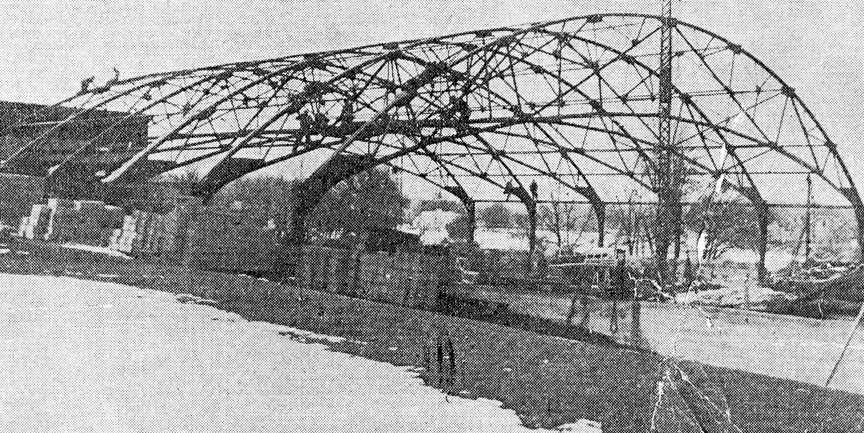
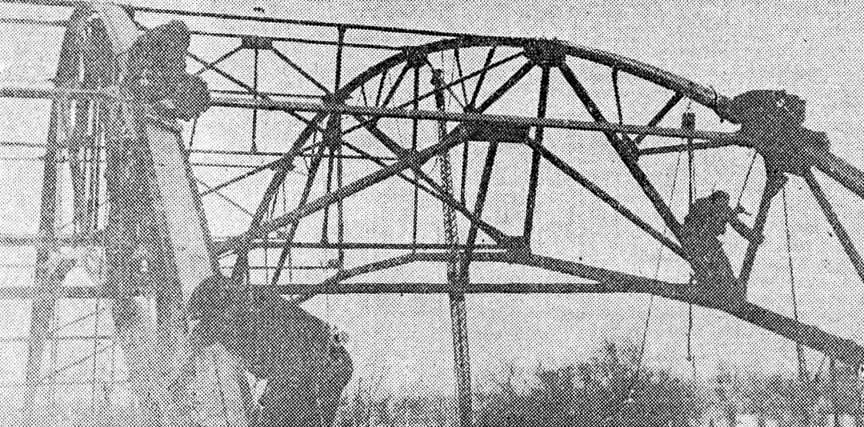
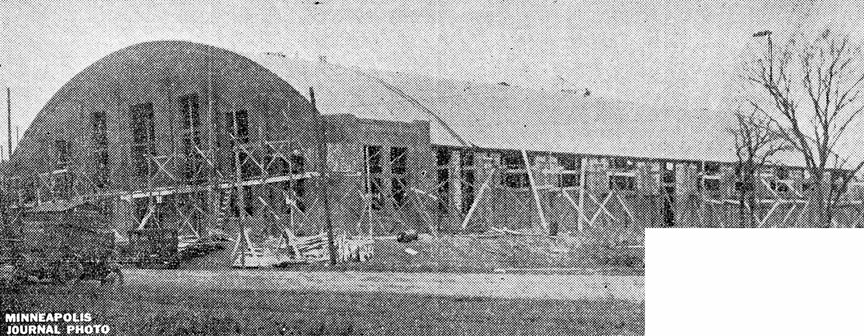
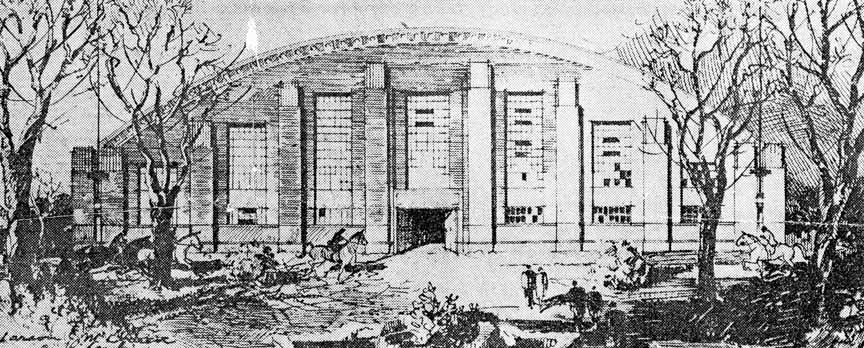
In May 1930 Allen opened the Pastime Arena [Indoor Riding Academy] at 5622 West Lake Street (between Webster and Xenwood). Some statistics:
- Estimates of the cost rose from $40,000 to $75,000.
- It was designed to seat 2,000 people for horse shows, extending the riding season.
- There was a raised a balcony for the judges.
- The riding ring was 129 x 222 ft., “spacious enough to meet the demands of the most pretentious horse show program,” according to the Minneapolis Journal.
- There was a dirt floor, with a tan bark riding ring 218 ft. by 100 ft. – “ample enough for the roadsters to stretch their legs when a judge orders the drivers to ‘turn ’em loose.'”
- The arena was the first permanent building for holding horse shows in the Twin Cities other than the pavilion at the State fairgrounds.
- It was referred to as a “miniature University of Minnesota fieldhouse.
- Major construction was done by Peter “Pete” Pearson, a Swedish carpenter. His son Roland remembers some his dad’s workers as Ivar Skjelbostad, John Anderson, Axel Peterson, and Mr. Wickman.
- Accommodations included lockers, showers, dressing rooms, and lounging rooms.
- A ramp connected it to the existing barn, which housed 50 riding and show horses.
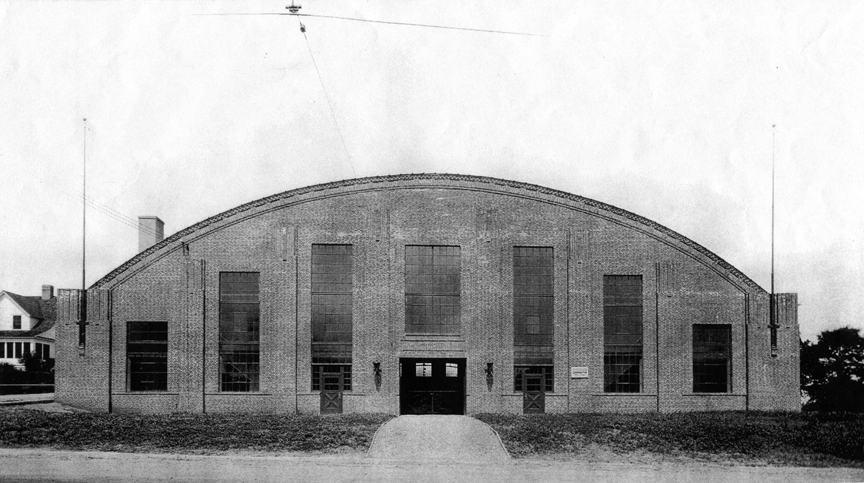
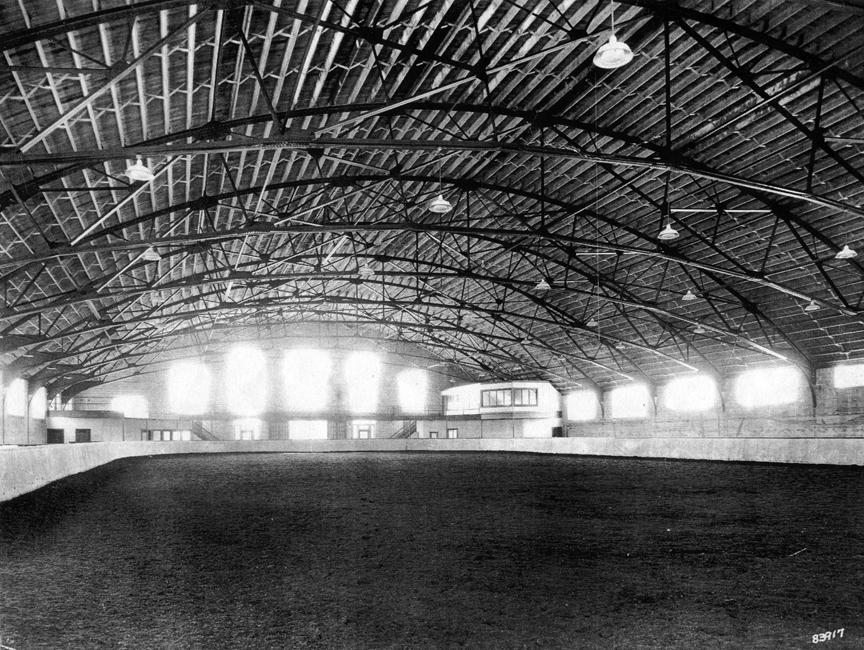
Pastime was to be used for a general boarding and riding stable, with a livery business. Many prominent figures from Minneapolis boarded their horses at the arena’s horse barns.

POLO AT THE PASTIME
A series of unfortunately undated articles tell a tale of exciting indoor Polo matches at the Pastime. Teams had three members and they played three periods, called “chukkers.” Three games were played at each event. One such article by frequent polo reporter Percy Turner reflects the ardor for the game:
Nine chukkers of blistering polo, providing the sort of play that puts you on the edge of your seat and tearing up your handkerchief, sent the northwest indoor tournament into its semi-final stage Friday evening at Pastime arena. The best crowd of the week was well repaid. The three games scintillated with skillful stick handling, lusty hitting and cagey strategy.
An article announcing the start of the indoor league reported that there were 50 active polo players in the league, making up at least eight teams that would play twice during the week and once on Sunday. The Pastime Polo Club was organized, and the members voted to apply for membership in the United States Indoor Polo Association. Officers of the club were :
- Maurice Krier, President
- Roy Witt, Vice President
- Percy E. Turner, Secretary-Treasurer. Turner was also the reporter for the unnamed newspaper in the clipping files.
- Ralph Walts, Herbert Johns, Witt and Krier, committee on organization.
Allen had his own team, called the Rocking Chairs to denote the advanced ages (40s) of the team members. The other members were:
- Thomas Kidd , a British Army veteran who worked at the arena as a riding instructor; and
- Maurice E. Krier, described in one article as a “veteran indoor and outdoor star.” Son Harrison Allen remembers stories about the gray-haired Krier would “charge into a group of players and close his eyes while taking a swing at the ball.”
The Rocking Chairs played mostly for fun; one article reported that the opposing team “showered polo balls at the goal of the Rocking Chairs so quickly that they forgot to rock and were completely hopelessly beind at the end of the second chukker with the score 10-2.”
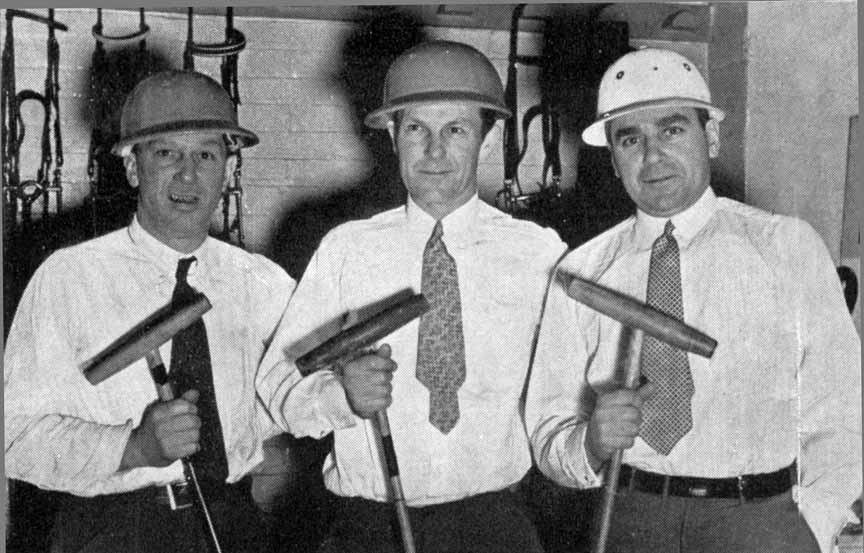
Unfortunately, the Rocking Chairs were no match for the many other teams, often filled with young men from other stables or attending universities. The team to beat, though, was Army, out of Fort Snelling, all Lieutenants.
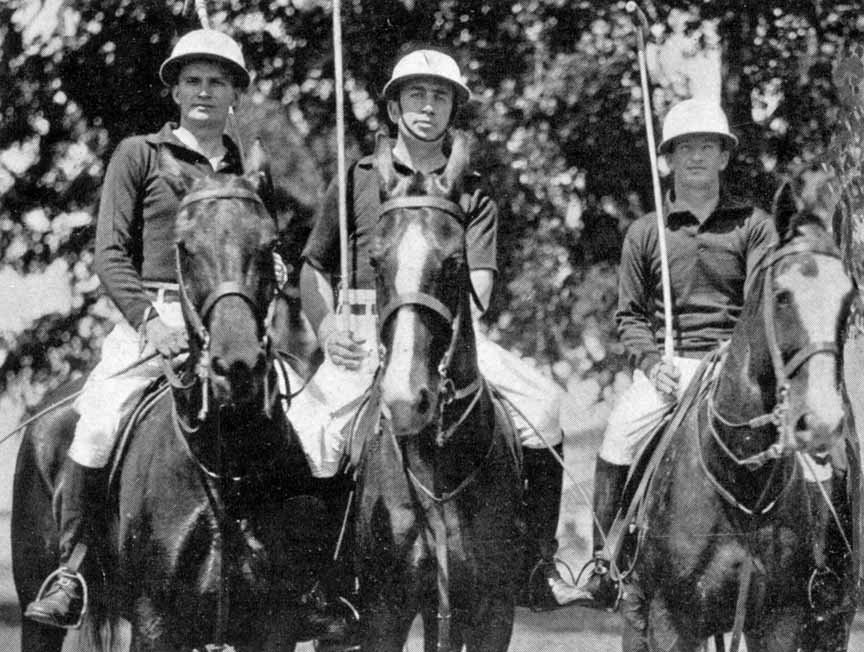
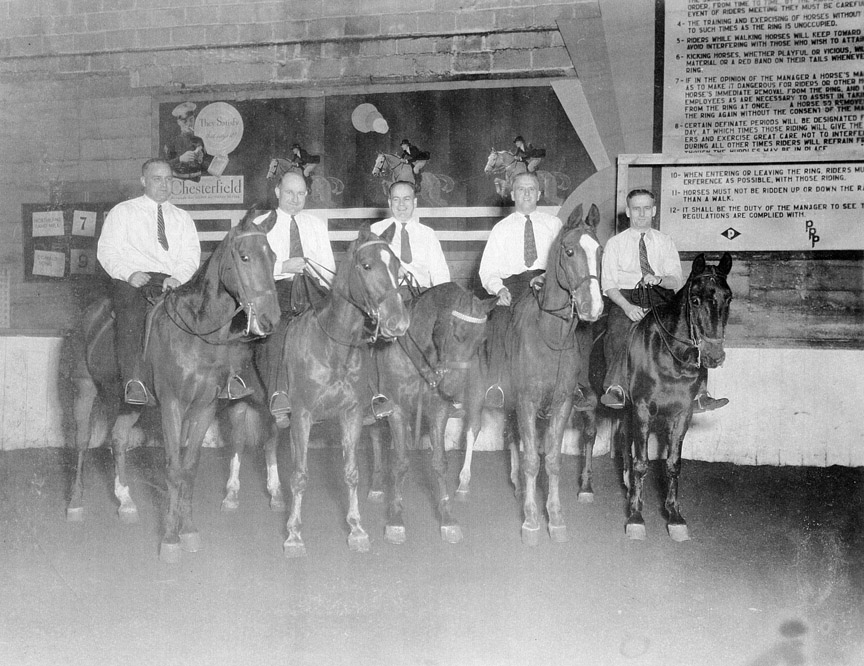

HORSE SHOWS
Throughout the 1930s the Arena was used for horse shows, sponsored both by the Pastime and by other organizations.
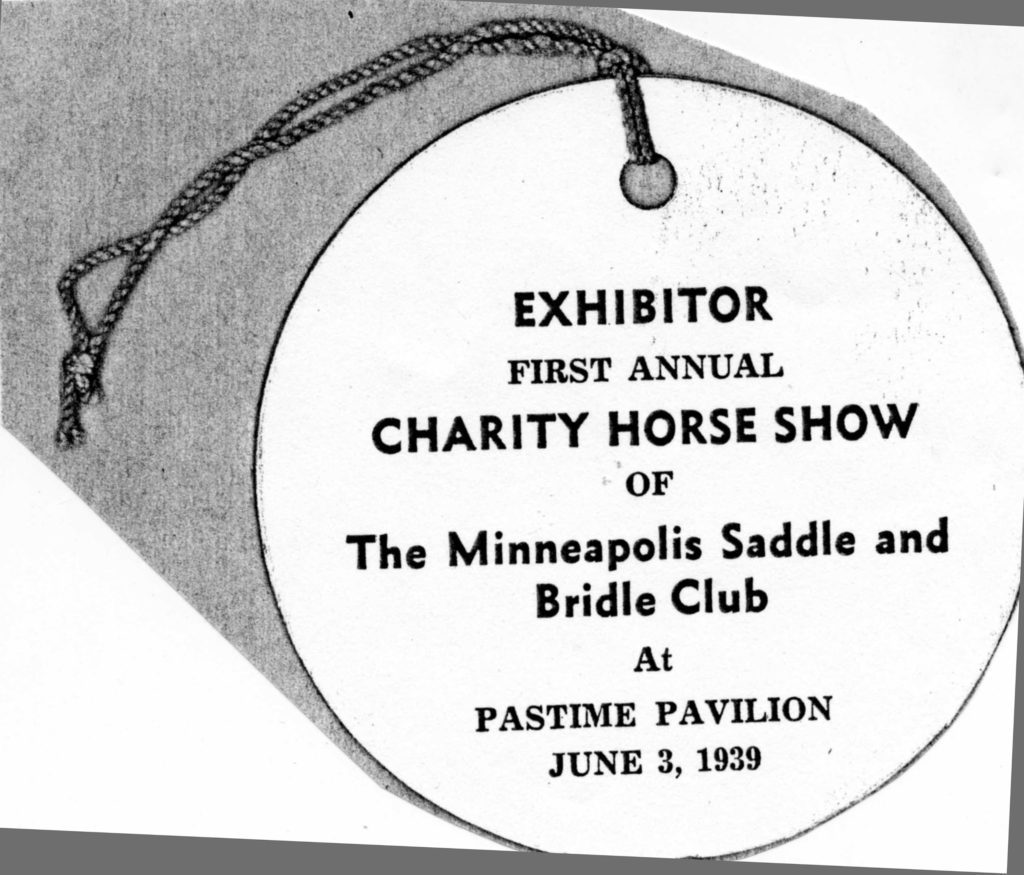
CHANGING OF THE GUARD
Harrison Allen wrote, in Something in the Water:
Pastime arena was built just at the beginning of the Depression and operated through the 1930s as was intended. Its success, no doubt was somewhat limited because of the difficult economic circumstances of the times. As World War II approached, many of the wealthy people who had a large part in financing the arena had grown older and the younger generation didn’t have the same interests.
In 1939 Allen sold the Pastime to Arthur J. Eaton and a woman partner from Chicago. The Allen family moved to their farm at Cedar Lake Road and Hopkins Crossroads. Herb continued to judge horse shows into the 1940s. Allen converted the hayloft of the barn into a dance floor and rented it out for parties. In the winter of 1940 or 1941, the barn burned to the ground the morning after a party. All 30 horses were saved, but it was a large personal blow to the family. Allen died of a heart attack in about 1947 and his wife moved to an apartment in Minneapolis.
ARTHUR EATON

In 1941 it was called the Lilac Way Riding Academy and Pastime Arena, featuring indoor riding and beautiful bridle paths. In the winter, the owners would flood the south half of the floor and make the facility available for “for figure and general skating. Competent Instructions, Good natural ice. Music by Electric Organ.” The 1941 skating season opened on December 1. A similar notice was posted in 1942.
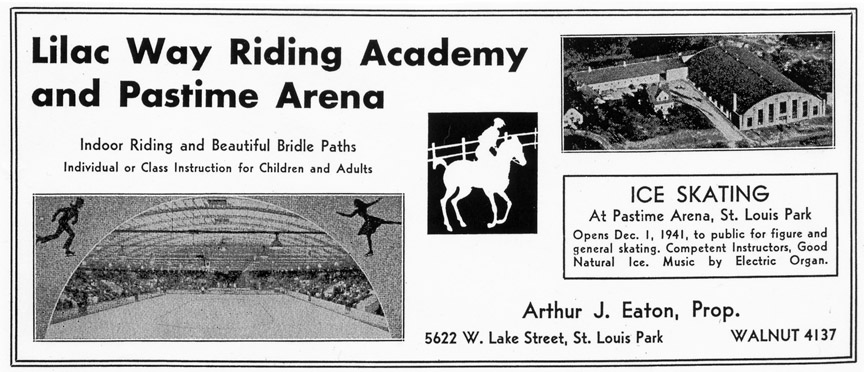
Rumor has it that during World War II Eaton removed the copper roof and sold it, fetching the same amount as what he paid to buy the building. Current owner Bill Sahly says that this makes for a good story, but, unfortunately is a (sub)urban myth.
On October 18, 1943, the Council passed Ordinance 199, entitled “An Ordinance Regulating and Licensing Livery Stables and Riding Academies.”
ROLLER SKATING
In about October of 1943, Arthur Eaton installed three portable flooring pieces on the south half of the arena and added roller skating to the offerings. The facility was called the Pastime Arena Roller Rink – “One of the world’s largest rinks.” Music by Tommy Arsenault. The other half was still dirt for the horses. At the time the 10-acre grounds consisted of the arena, a horse barn, and a house (or 3). A fall 1943 ad in the Echo included roller skating, Pastime Arena, saddle horses, hay rides, lunches, party floor, Lilac Way Riding Academy – no beer, no liquor.
Almost immediately, people began to complain about the roller rink. The issue first appeared as a discussion of the Village’s curfew ordinance at the council’s January 24, 1944 meeting. Councilman Torval Jorvig stated that the present law of 9:00 pm was not workable, as it did not give children time to get home after school parties and games. The issue was referred to the PTAs for their opinions.
The next week, January 31, Police Officer Mildred Fagan reported five cases of children between the ages of 11 and 13 being out after 10:00 pm. A suggestion that the Park follow the guidelines of Minneapolis was objected to by Councilman M.T. Tierney, who pointed out that there were fewer places in the Park for kids to congregate, and that a new ordinance should not stand in the way of youth recreation. Again the issue was put off pending consultation of the Superintendent of Schools and the Board of Education.
At the February 7 Council meeting, citizens came to air their opinions about a new curfew. The PTA suggested 9:30 pm. Nancy Thomson, representing the student council, opined that an enforced curfew was unnecessary, but if there was one it should be consistent with the surrounding communities. School Board president D.W. Fletcher felt that whatever was passed should be rigidly enforced. Mrs. Frank Gilbert worried that an early curfew would interfere with meetings at the Methodist Meeting House (which later became Aldersgate Methodist Church). Police woman Fagan said that the problem was centered on kids aged 10 to 13 who loitered around the roller skating rink along with groups from outside the Park who patronized the rink. Recorder Joseph Justad took Fagan’s remarks to indicate that “delinquency among older children had been cleared up.”
Since the roller rink appeared to be the reason for the complaints of curfew scofflaws, the Council went after the rink. On February 14 they passed Ordinance 203, regulating and licensing roller skating rinks. They took great care to define the terms, even though everyone knew there was only one roller rink in town. The ordinance required that the place to be licensed must “not likely to become a public nuisance or detrimental to public morals.” The license fee was set at $25. Other rules included:
- The rink must be illuminated while in public use; roller skating while the lights are extinguished or turned low was prohibited.
- Nobody under the age of 16 could be on the premises after 9:30 pm.
- The rink must close at 11:00 pm, except that with a special permit it may be kept open until 1:oo am as long as “sounds resulting from activities carried on within are not audible in adjacent residential areas.”
Violations were misdemeanors, punishable with a fine up to $100 and up to 90 days in jail. The ordinance went into effect on February 19, 1944.
Arthur Eaton, who had been operating the rink without a permit, came to the next Council meeting on February 21 to defend his operation, saying that 90 percent of his business was with schools, colleges, and churches, and that they bring chaperones with them. Also, many parents leave their children under the supervision of the rink’s manager, Henry Clear, while the parents go to a movie, etc., and therefore the children are not without supervision.
The situation ramped up on March 6 when a group of citizens from the neighborhood came to council to complain about the roller rink. Phil David of 5600 Minnetonka Blvd. said that when he moved to his house the Riding Academy was in operation and caused no problem, but “he did not feel that he could endure the noise from the roller rink since the organ music was very loud.” E.R. Kullberg, 3101 Xenwood, agreed that the noise was very disagreeable, and when the rink closed at night the kids waiting for the bus created a disturbance by “loud talking.” He also complained that they had bent over the street sign on the corner. The kids threw empty pop bottles in the driveway and trampled over the grass and shrubbery. H.E. Friedlund of 2940 Webster was also upset about noise and the cars of young people parked in front of the facility. D.J. Sunde said that last fall he had to keep his windows and doors closed to keep out the organ music.
After the crowd left, Eaton appeared and tried to appease the council, saying he had plans to meeting with the bus company and coordinate the schedule with the rink’s closing time.
Other citizens appeared with moral complaints: A.F. Gendreau of 3053 Ottawa said that his son had played cards in the barn, but did not know whether he “played for stakes” or not. He also charged that “young couples sometimes left the skating floor and wandered up to the balcony.”
The next week, March 13, Kuhlberg presented a petition signed by 40 residents arguing against the issuance of a license for the rink. They also complained that it was within 500 feet of a church, and the noise might disturb meetings there. Mrs. Kuhlberg made the point that Eaton had a successful stable business and he would have no problem making a living without the roller rink..
Councilman C.L. Hurd cast aspersions on the “type of children and young people who frequent the rink” by saying that the bus drivers reported that they did not want to pay the bus fare and “otherwise make themselves a nuisance.” G.B. Townsend, attorney for Eaton, said “Children need a place to go where good conduct is looked up to.” Other neighbors complained that the rink would bring down their property values.
On March 20 the council voted unanimously to deny the application for a roller rink permit. This despite an outpouring of support:
- Eaton presented a petition from property owners asking that the license be granted.
- Scoutmaster Willis F. Arnold wrote a letter of support.
- Bob Galloway, sophomore at Park High, presented two petitions signed by 300 students and parents.
- Floor manager Mr. Thomas, Manager Clear, and Watchman Larry Kleer reported that the children were well-behaved and pointed out that no liquor was allowed.
- Ernest Fitch, the veterinarian who lived next door, said that the noise did not bother him and both his animal hospital and the Pastime Arena had been built before the homes in the area.
Despite all this, the council cited several reasons for their denial of the permit:
- Minors under the age of 16 had repeatedly been allowed to remain on the premises after 9:30 pm.
- Minors and others had frequently been disorderly in and about the premises.
- The property was a fire hazard.
- The continued operation would result in “substantial depreciation of residential property in the vicinity.”
- The rink has been repeatedly operated with inadequate lighting.
At the April 3 meeting, discussion continued, including story of x McCullough’s fatal fall from her horse at the Riding Academy. “There were those who contended that the rink is a nuisance and a moral detriment to the community, and those who just as stoutly maintained that it is a wholesome agency of entertainment for the youngsters.
Eaton wasn’t going down without a fight. On April 7 he published a long statement in the Dispatch entitled “More About Roller Skating at Pastime Arena.” He had taken the Village to District Court, arguing that he shouldn’t have to have a permit to operate. Eaton won a temporary injunction against the Village, handed down by Judge Vince A. Day. He vowed to stay open pending the decision. He described his other properties and the activities there, and declared that “roller skating is the safest and best of all. They can roller skate for three hours without over exertion; it is easy to keep good order and chaperone; they skate to music, which encourages grace and charm; young folks must be given a chance to laugh and have good wholesome exercise.”
During the week of April 17, Judge Frank E. Reed held a hearing on the issue, with Village Attorney E.T. Montgomery arguing for the Village and George Townsend appearing for Eaton. Reed held the case under advisement pending the filing of briefs by the attorneys.
On April 24, Judge Reed issued another temporary injunction enjoining the Village from closing the Roller Rink until the case was tried on May 15.
ENTER THE SPERZEL COMPANY
Meanwhile, another wrinkle appeared in the form of a request of the Sperzel Company for permission to set up a plastics factory in the building. They were going to have to vacate their location at 911 Hennepin Ave. in Minneapolis. Their plan was to purchase the arena, horse barn and thee house. The horse barn would be torn down or used for storing materials. The lots to the east would be filled in and a shipping and receiving platform would be built.
Use of the Pastime would have required the property to be rezoned for heavy industry, and the planning commission put a quick kibosh on that idea at a special meeting on April 25. Reasons for the denial were myriad:
- the people in the surrounding residences would object to re-zoning even for light industrial purposes
- heavy truck traffic would tear up the streets
- the number of employees “would probably create as great a disturbance as the customers of the roller rink”
- there might be round-the-clock shifts, with noise and people coming and going day and night
- parking would be a proble
- real estate values would go down and the residents would hold the Village responsible
- if the company left, it might bring in some less-desirable type of manufacturing
However, the planning commission offered to help the company find another location in the village suitable to its needs, and left open the possibility that the company could apply for a limited permit for the duration of the War. The company – and Eaton – called its bluff and applied for the limited permit. At its meeting on May 2, the Planning Commission approved a five year special permit with several conditions, including
- no rezoning of the area
- no soft coal used
- a limit on the weight of trucks
- working hours subject to wishes of residents
Well, 100 people jammed the Council chambers at the May 15, 1944, public hearing, and although the representative of Sperzel said that the company only had 25 employees and that there would be no noise or smell, there was universal opposition to the plan. Two particular arguments, other than having a factory in their back yards, were that they doubted that the company could get the materials needed to retrofit the building during wartime, and the disapproval of the use of coal.
Several others expressed similar opinions before Mayor Erickson summed up the arguments saying he believed the council had learned the attitude of the residents, that they were opposed to the company. At this the audience applauded. The council then formally voted down the application for a permit.
Was the Spertzel bid a legitimate offer, or a clever way for Eaton to threaten an even more odious use of the property? Either way, it worked, as we shall see:
The case apparently went quiet for a while; it comes up again at the council meeting of August 7, 1944:
The case of the Lilac Way Riding Academy and roller rink was brought up and attorney Montgomery said the case was set for Sept. 12. It was decided that the council should consult residents near the academy to see whether the causes for their complaints had been removed. Arthur Eaton … is asking a permanent injunction preventing the village from enforcing the academy ordinance.
At the meeting of September 25, 1944, Mayor O.B. Erickson “reported that he had contacted Arthur Eaton and that the business is being conducted in an orderly manner and that the things to which nearby residents objected had been eliminated. He also suggested that the council make an investigation of the rink, either separately or as a group, to confirm his observations.”
At the October 2, 1944, meeting Eaton made a formal application for a license but action was deferred.
Finally, with little notice, on November 13, 1944, “Arthur Eaton was granted a license for his roller rink, subject to several conditions set up by the council to govern parking, policing and closing hours. The council and Mr. Eaton are completely in agreement as to operation of the rink.”
THE DEATH OF LOIS McCULLOCH
On March 4, 1944, young Lois McCullough, 4618 Drexel Ave., Edina, died after being thrown by a horse at the academy.
On June 28, 1944, Lois’s father filed a suit for $20,000, citing negligence. The suit claimed that Lois requested her favorite horse, but it was not available, so she was given a different animal named “Technique,” with the assurance that the it was gentle. “The horse, however, was a vicious animal and ran away, throwing Lois to the ground,” the complaint charged. Eaton took the unconscious girl to his home, where she stayed “without medical attention” from 2:15 to 6:00 pm. Then Eaton drove her to her own home, where she died. The father charged Eaton with negligence and providing a “vicious and untrustworthy” horse for hire. He also charged that the inexperienced guide was no older than about 14.
Back on April 3, amidst villagers’ complaints about his operation, Eaton had “declared that the horse in question is the private saddle horse of Mrs. Eaton, that he is 14 years old and that he is rented mostly to girls and women. Miss McCullough had ridden the horse before and asked to ride him at this time so she was given this horse.”
Perhaps in response to the lawsuit, on July 17, 1944, the Council passed Ordinance 211, which amended Ordinance 199. It added the following requirements:
- All horses must be numbered and registered with the Village Clerk.
- Grooms and guides must be over age 15.
- Horses may not leave the stable when anyone under age 12 is riding or driving unless accompanied by an adult.
- Someone competent in first aid must be present at all times that horses are being rented.
- The owner/operator of the livery stable must keep a record of the names of everyone who rents horses.
- Horses may not be ridden on public streets from an hour after sunset to an hour before sunrise.
The ordinance was effective on July 21, 1944.
The outcome of the lawsuit is unknown.
1945
The horses weren’t quite phased out yet:
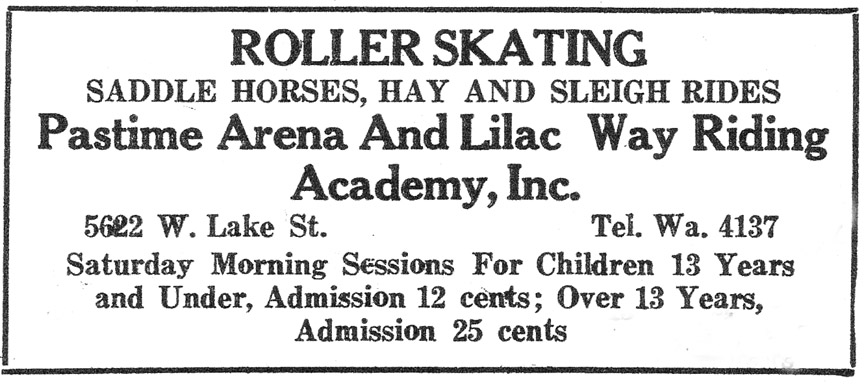
On July 28, 1946, Eaton held a rodeo, horse show, and musical entertainment at the Pastime.
EATON’S RANCH
The ad from 1947 has a sub-ad to “Visit Eaton’s Dude Ranch” on Cedar Ave., 4 miles south of the Minnesota River. Eaton’s Ranch opened in Apple Valley in 1930, offering hay rides, sleigh rides, trail rides and rodeos. Art, Sr. sold the ranch in the early 1970s, but Art, Jr. repurchased it several years later. He offered horse boarding, sleigh rides and hay rides, opened a restaurant called the Maverick, and Eaton’s Western store, which operated until it was taken by the highway department for the expansion of Cedar Ave. in 1982. As the Twin Cities expanded, Art, Jr. sold off parts of the family ranch to create such Apple Valley neighborhoods as Palomino Hills, Timberwick and Saddle Ridge. “A lot of other developers would try to get as many homes in there as possible,” said homebuilder Rick Kot “His pieces were some of the first nicer developments in there.” (StarTribune, November 17, 2016) The Apple Valley High School is located on former Eaton’s Ranch property.
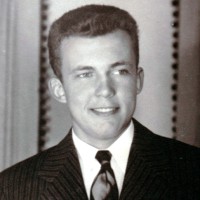
Eaton, Sr. was reported to own ten western cattle ranches.
PETE PETERSON
From 1945 to 1948 the facility was rented and operated by C.E. “Pete” Peterson. Village Council minutes in 1947 show that I.H. Rickerman and Peterson were admonished not to have horses on public streets – all lessons were to be held inside. (Many people remember seeing people riding horses alongside Highway 100.) Rickerman and Peterson also bought and sold horses. In 1948, Peterson went on to start his own facility, Valley View Stables, in Edina.
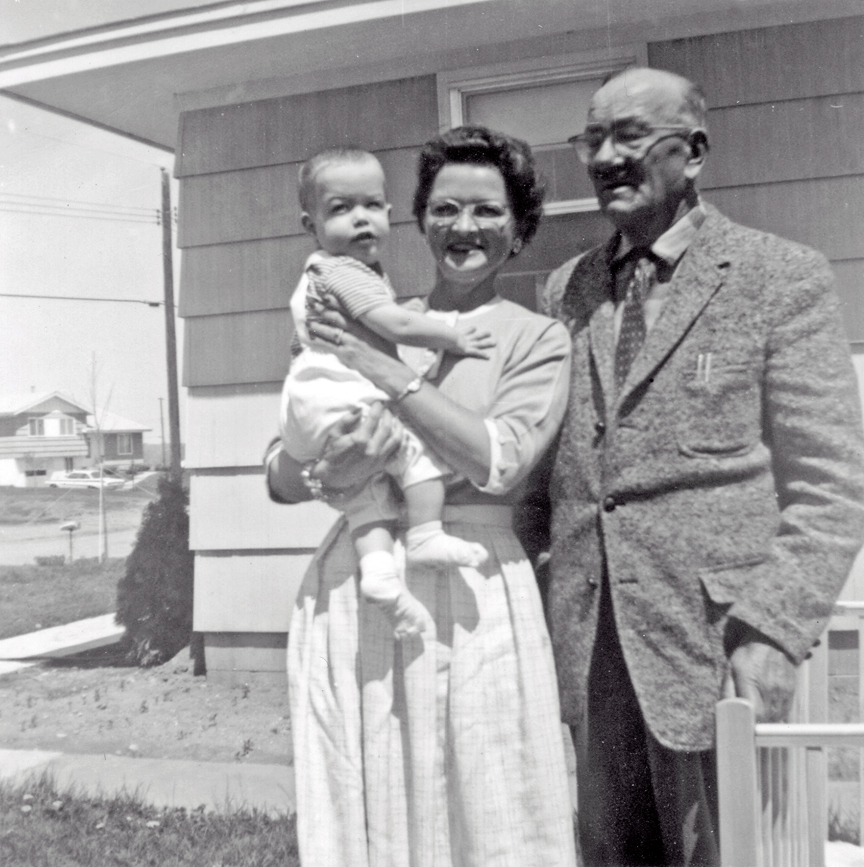
Roller skaters in the 1940s must have been rowdy, for in 1947 and 1948, the Village added special police for the rink and in 1948 the Village Council saw it necessary to pass a roller rink ordinance.
BACK TO EATON
In 1950 Arthur J. Eaton presented plans to turn the property into a shopping center. There was much resistance to the notion.
A cryptic note in August 1951 says that Lee Redman petitioned the Village Council to re-open Pastime Stables for boarding only. His request was denied.
Art, Jr. told Bill Sahly that when he returned from the Korean War (approximately 1952), his father had sold the arena.
TENNIS
In 1957 Eaton sold the arena to the Park Investment Co. for $270,000. Around that time, sheeting was put in and the facility was given over to tennis – the first indoor tennis venue in the Minneapolis area.
There were problems with indoor tennis, as Minneapolis Star columnist Larry Batson pointed out in a piece published on November 13, 1974.
- Birds somehow got into the building. “On a tough match point, the regular players would stall, hoping that one would swoop in front of their opponent at the right moment.”
- It was loud. “The cavernous structure with its bare masonry offered the acoustics of a rain barrel. Sounds would reverberate endlessly, mixing and clashing.”
- The huge windows created patterns of light and shadow, further flummoxing the players. “A player could stonewall it in the shadows, stroking returns from the dark into the bands of sunshine.” Johnston said, “On as sunny afternoon there would be bands of light and shadow striping the courts. You couldn’t pick up a ball to save your soul.”
- The asphalt floor couldn’t have been too kind to the players’ joints, either.
The three photos below are courtesy of Bill Sahly, who says that the saying was, “If you could play at the Roller Garden you could play anywhere!”
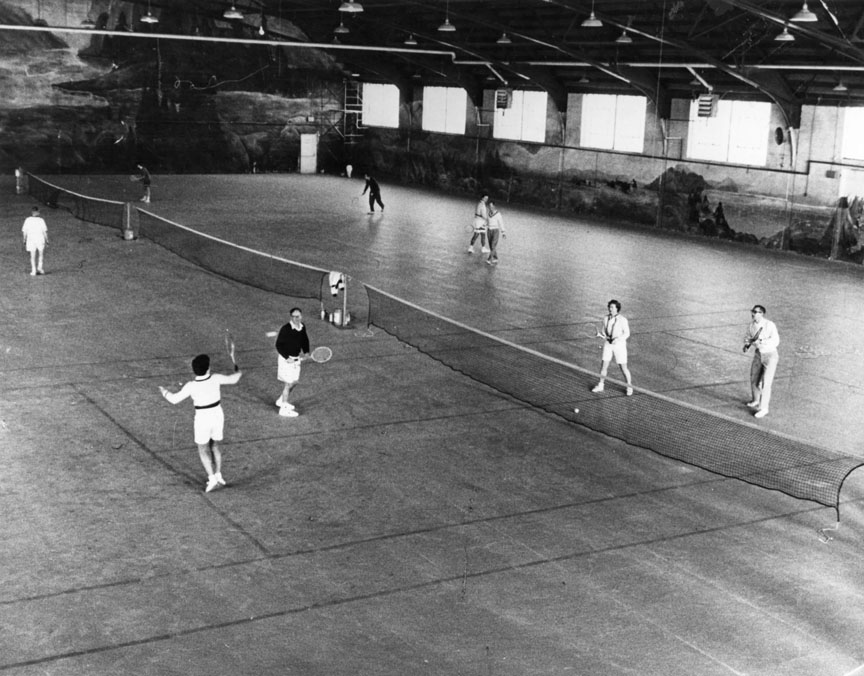
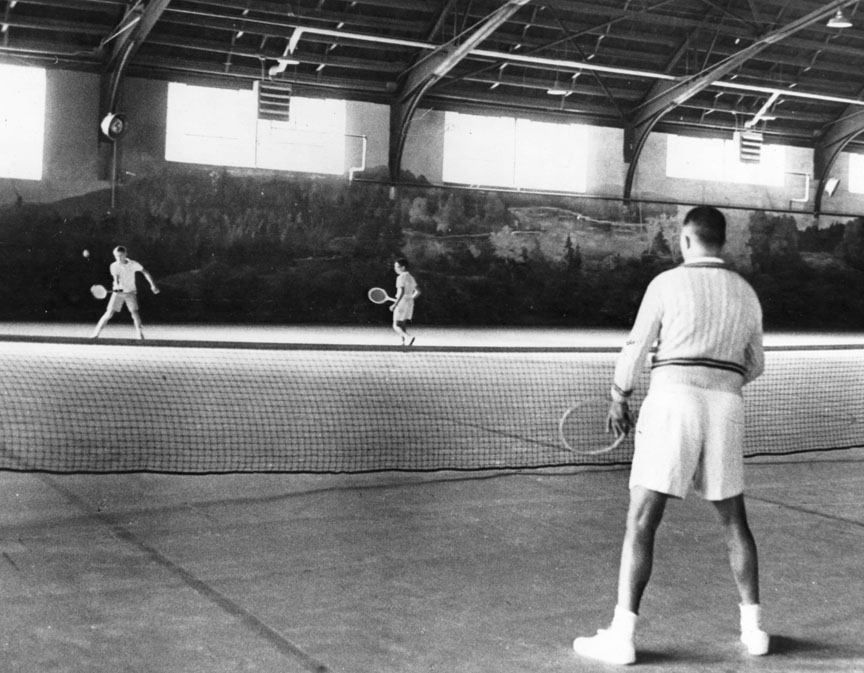
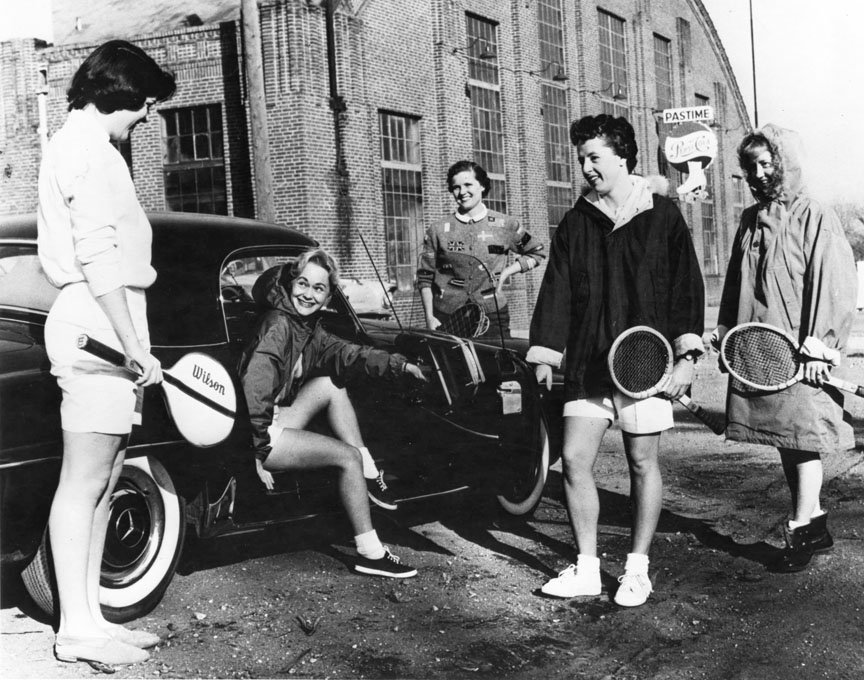
In 1958 manager Larry Tobin came before the City Council to request permission to hold a public dance at the Arena on October 3 from 10-11:30. Only Councilman Jorvig voted nay. Subsequent dances were approved as well.
Ads in early 1958 referred to the facility as the “Pastime Roller Rink.”
HOWARD HARDACKER
In September 1960 (1962) it was sold to Howard Hardacker, who put in a plastic floor for three tennis courts. The 1964 directory referred to it as just the Roller Garden, and the facility became a part time rock ‘n’ roll dance venue. Other activities included Fire Department smelt fries and the new Hudson car show. Michael Ostlund remembers a Trashmen concert/dance and that the band dubbed the venue the “House of Echo.” Could that be the same dance of 1963?
In 1963 WDGY DJ Bill Diehl was the mc at a Halloween dance at the St. Louis Park Roller Rink featuring The Trashmen, who had released their national smash hit, “Surfin’ Bird” earlier that month. Expecting about 800 kids, an estimated 2,100 showed up. The enthusiastic crowd shattered the building’s glass front wall, and reinforcements were sent for from the local constabulary. Even at only $2 a head, money was made in bucketfuls, and presumably St. Louis Park teens enjoyed its night with their favorite local surf band.
RUSSELL JOHNSTON
On February 1, 1969, the building was purchased by Russell C. Johnston. Johnston grew up on a farm in Beach, North Dakota, and became quite an accomplished piano and organ player. Family lore is that he worked his way through college at the University of North Dakota in Grand Rapids by playing piano at a speakeasy! He had played with some big bands, and had both a baby grand piano and a Hammond organ at home. And he loved to play the organ at the Roller Garden.
When he bought the building it still had a dirt parking lot and he had to build the retaining wall. The skating surface was “asphaltic mastic” – a mixture of asphalt and Portland cement. In 1972 this was replaced with a kind of very dense particle board, which lasted for 30 years.
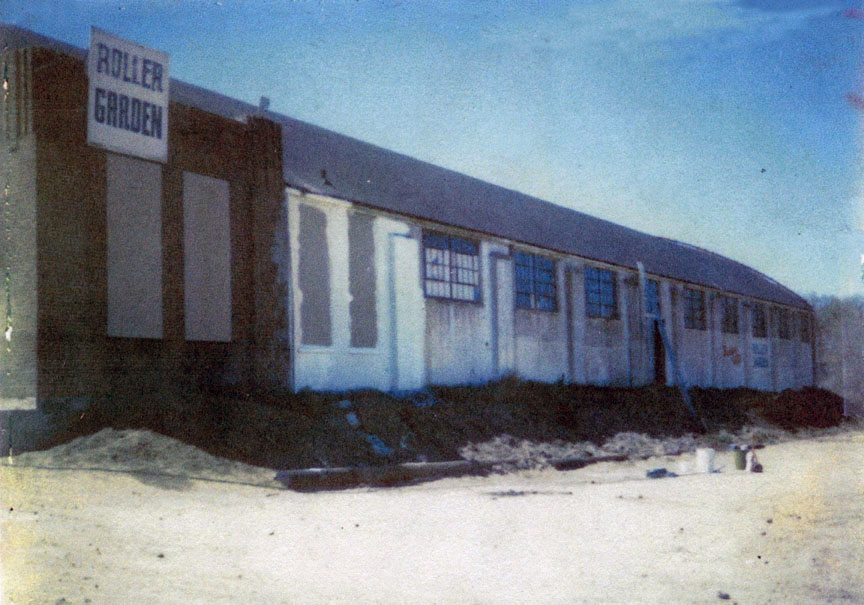
The Roller Garden caught fire in 1969 when a tar heater owned by a roofing company burned through the roof. The fire department poured water from the outside, and the owners had fire extinguishers on the inside. Although some folks in the crowd shouted “Let that old barn burn down!” water was squeegied out the back door and the rink only opened a half hour late with a “Moonlight Skate.”
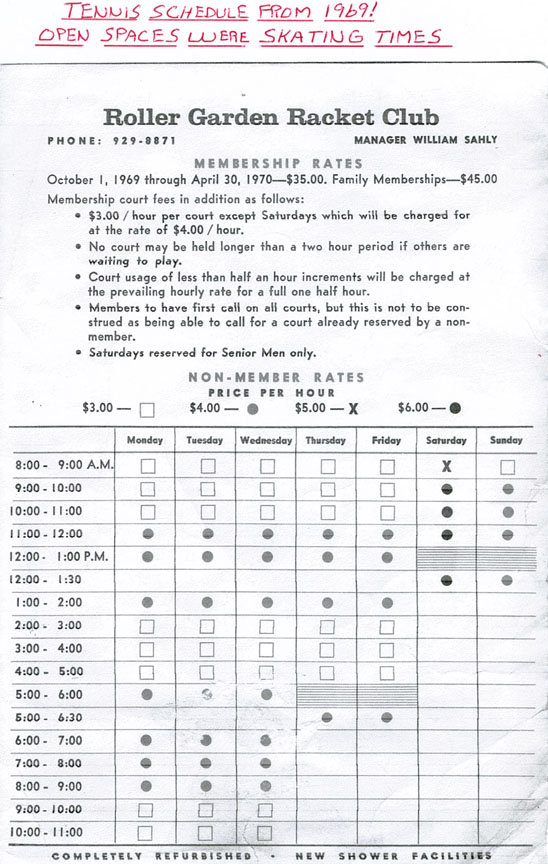
There apparently had been some trouble in 1970, when Johnston was called to a City Council meeting to “answer charges of vandalism and hoodlumism that his establishment was accused of being responsible for encouraging,” according to a letter to the editor of the St. Louis Park Sun from Sy Friedman, published on April 2, 1970. Friedman said that in the past, it had been “a place where you have to be afraid to leave young children without supervision,” “worry about the rowdies and drunks that have been known to frequent the skating rink in days gone by.” On a visit to the Roller Garden, Friedman saw none of this activity, marveling instead at the sight of “several hundred people, young and old, rich and poor, black and white, male and female, gathered for a fun-loving afternoon in a healthy atmosphere of cleanliness and respect for one another.”
In 1972 the Garden purchased a $10,000 Hammond organ and installed new soundproofing.
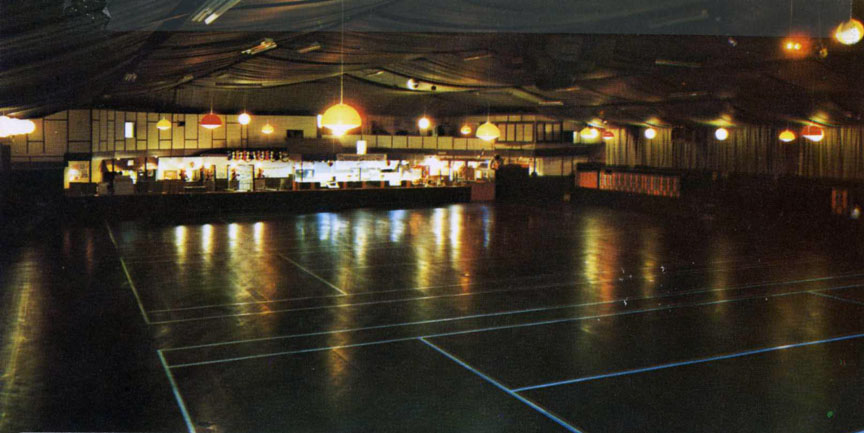
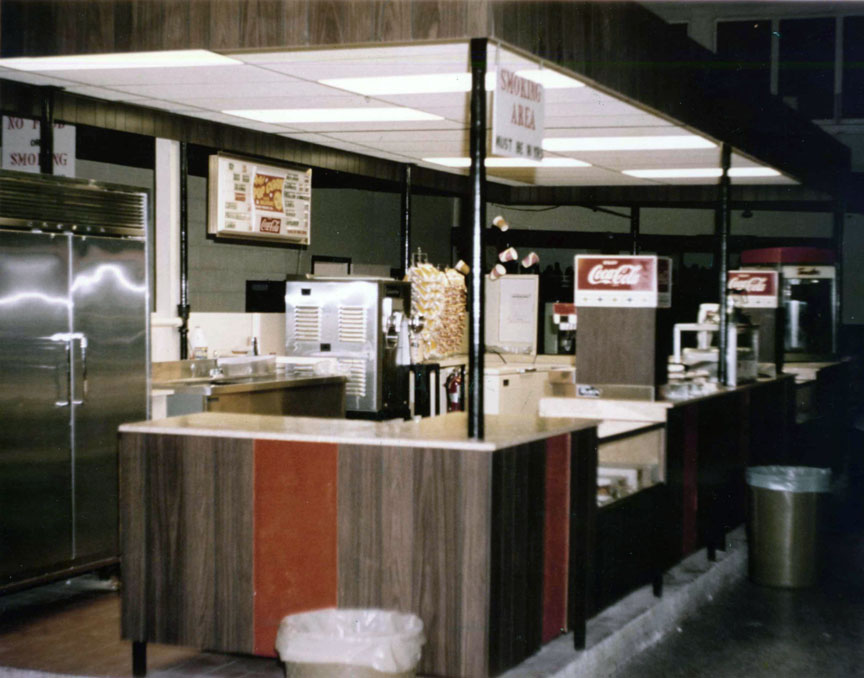
In the summer of 1974 the building was sprayed with foam insulation.
In 1974 Johnston told columnist Larry Batson that about 4,000 people per week skated at the Roller Garden. “Our changeover time from skating to tennis, or vice versa, is three minutes.”
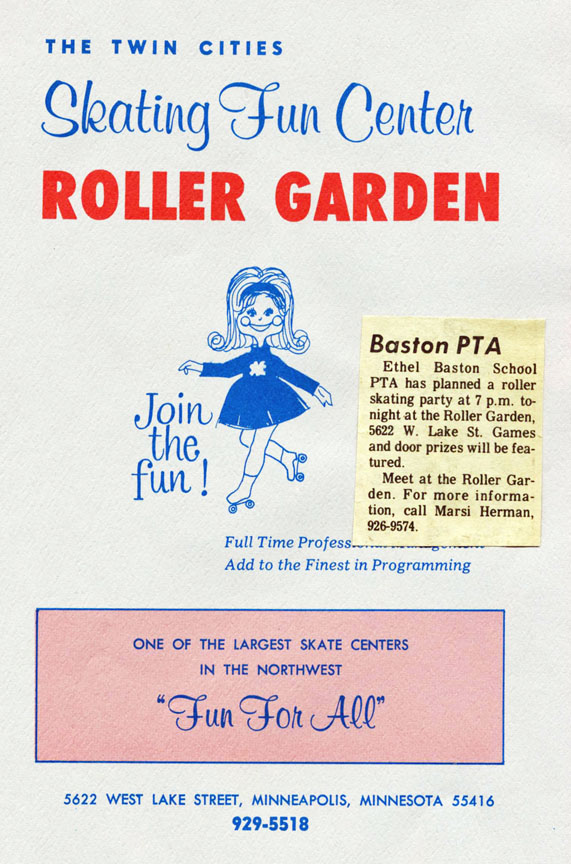
WHAT’S THAT RACKET?
It was still a part-time tennis venue in 1975, when Johnston got in trouble with the city for painting a huge tennis racket on the building.
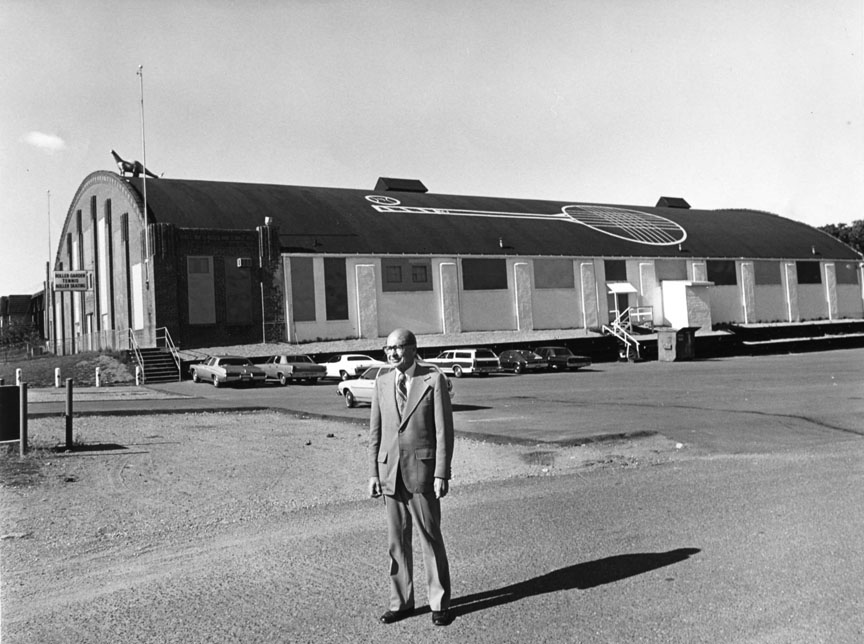
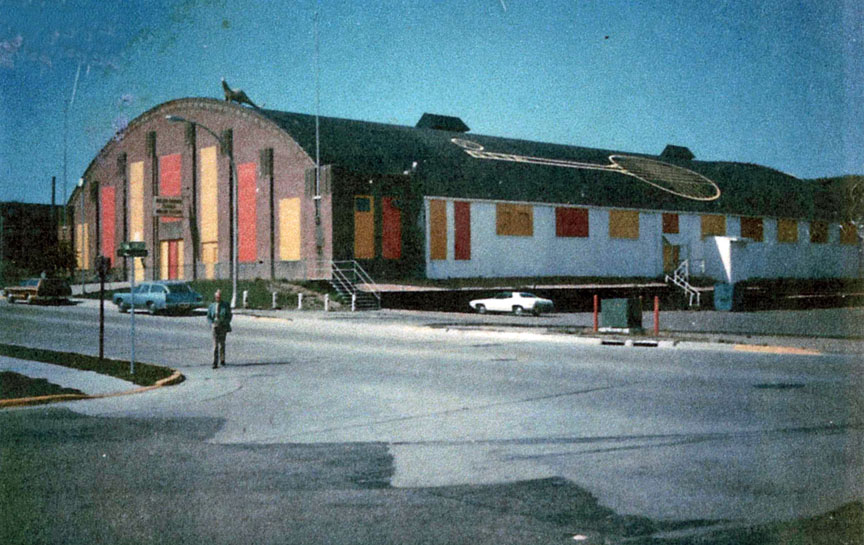
The next year, in 1976, Minneapolis Star columnist Barbara Flanagan wrote about the brouhaha surrounding Johnston’s decision to paint a giant tennis racket on the roof of the building. Johnston said he was inpired by the famous music mural on the wall of the Schmitt Music Co. in downtown Minneapolis. “He like the idea of using only a symbol instead of letters.” Johnston’s son-in-law, Bill Sahly, liked the idea and painted the giant racket on the roof himself.
But St. Louis Park told the owners that the sign was illegal because it was bigger than 60 square feet. Johnston said, “They told me that I could dput anything up there I wanted to – even yellow graffiti – as long as it doesn’t have anything to do with the business I’m in.” Flanagan dryly added, “At the time, I didn’t realize the area is zoned residential because the building is in a commercial area dominated by gasoline stations.” She ended the column, “I think it’s your serve, St. Louis Park.” The city backed off and the sign stayed until the roof was replaced.
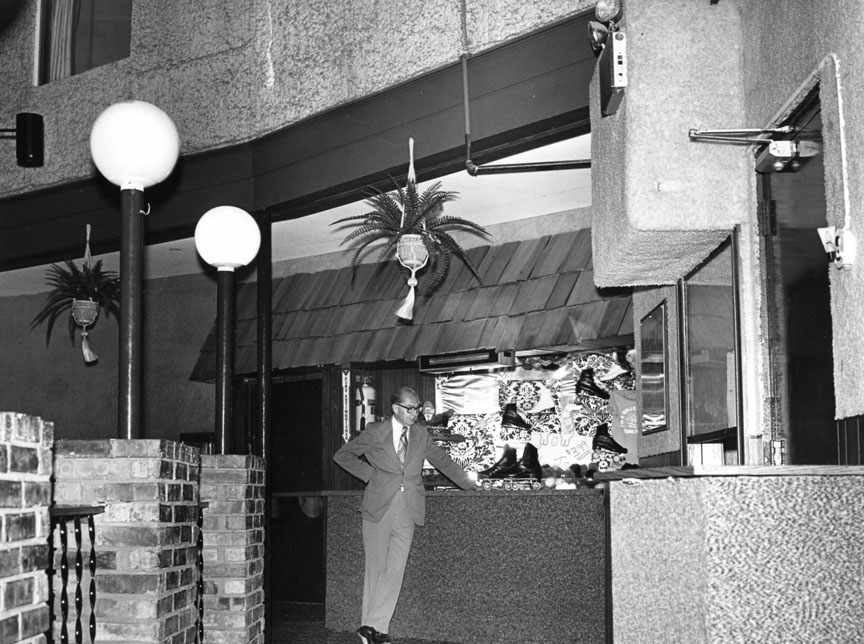
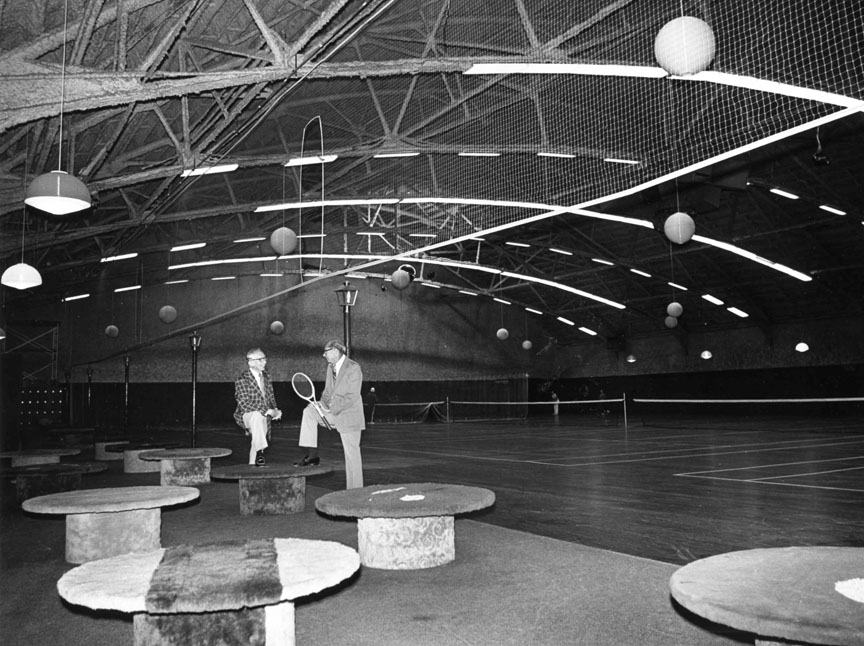
Tennis was dropped in the late 1970s as better courts became available and the boomers made roller skating popular again. The height of roller skating’s popularity may have been 1974, when there were 15 rinks in the Twin Cities. Colorful laces and “poms” were popular with the girls, and some kids spent several nights a week going ’round and ’round.
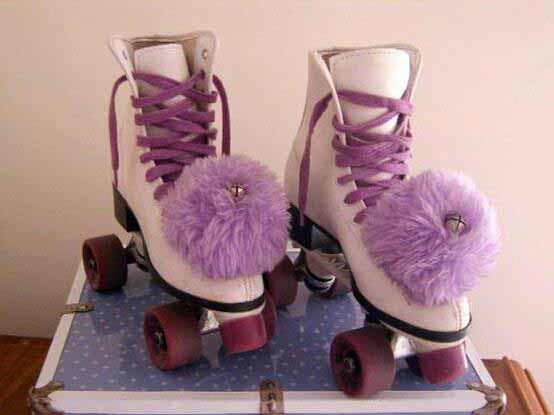
MR. ROLLER SKATE
For years a regular customer was L. Everett Carlson, a kind of folk hero who skated at the Roller Garden until he was 94. He is pictured here in a Minneapolis Tribune photo with Russ Johnston in about 1978.
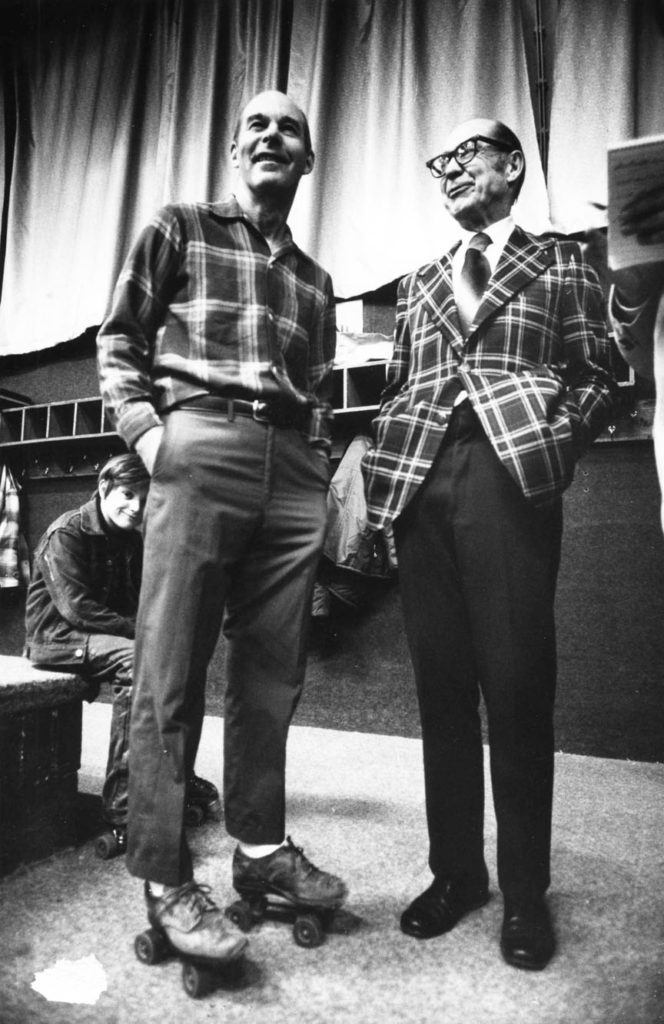
BILL SAHLY
Johnston’s son-in-law, Bill Sahly, took over management, and it is still very much a family business. Other owners are Bill’s wife Pat, and her sister and brother-in-law, Colleen and Levi Johnson.
COME ON, HEAR THE NOISE
With all those kids, the venue was plagued with complaints about noise, from the sound of the skates, the music, the DJ, etc. In 1983 the building had no air conditioning, and skaters would open the doors to cool off.
A 1983 article reported that the City was thrust into the controversy when it was presented with a petition with 50 signatures. The opposition was led by Fritz Noble of the Colonial Terrace Apartments. Booming bass notes, the disc jockey, and music escaped into the night through air vents and open doors. Noble also complained that “drivers honk horns and spin tires as they leave the parking lot at night, sometimes littering, drug-dealing and drinking in the lot.” One man complained that some patrons “do their bathroom pleasures” out in the parking lot. The petition asked for a supervisor in the parking lot and an alarm on the fire doors so managers will know when patrons open them.
Sahly agreed that an alarm on fire doors might work, but denied that the noise was a problem. He pointed out that the rink holds benefits for community groups and jobs for local youths. “I don’t want my neighbors to have to suffer, but some people undoubtedly are unhappy whenever anyone is having fun. People enjoying themselves shout and laugh. There are some people upset by that. I feel badly for them.” Although Sahly said that air conditioning would be too expensive, he pointed out that the Roller Garden had taken steps to curb the noise, including:
- free-standing noise barriers
- shrouds for air vents
- noise baffles inside the building
- acoustical insulation for the ceiling
- realignment of speakers
- keeping fire doors closed
City Inspector Manny Camilon was assigned the task of mediating between the two sides, and noted that the Roller Garden is trying to cooperate, but recommended that Sahly buy an air conditioner. (Minneapolis Star and Tribune, July 14, 1983)
In 1991 a dropped, insulated ceiling was installed to further try to curb the acoustics.
A 1990 news article reported, “Around 1986, blacks began roller skating in increasing numbers. The Roller Garden developed themes for teen-aged blacks who became the largest identifiable group skating on Friday nights. On Friday nights the skaters’ average age was approximately 12 years, they were predominantly black and had traveled over three miles to go skating. On Sunday nights the skaters’ average age was approximately 20 years, they were predominantly black and had traveled over three miles to go skating.”
The article goes on to detail three incidents outside the Roller Garden involving guns during a six-month period:
- On October 27, 1989, police were called in respponse to a crowd of about 50 to 150 youths who had gathered and several fights broke out. An officer was struck making an arrest, and five juveniles were arrested outside of the Roller Garden.
- On November 5, 1989, five men reported that they had been shot at by people in two cars. Two other young men told police that they had been jumped by the five men because one of them was seeing the sister of one of the five. It was believed that the sshots fired at the five men from the vehicles were in retaliation for their assault on the two young men. Four or five men were arrested and three weapons seized. 10 to 15 shots were fired but nobody was hit. None of the people involved were customers of the Roller Garden.
- On November 12, 1989, St. Paul Police notified St. Louis Park Police that a shooting might take place at the Roller Garden. SLP Police saw a group of men nearby, confiscated a number of weapons, and arrested suspects on weapons possession charges.
- On April 29, 1990, gunshots wounded three people in the Roller Garden’s parking lot. None of the people involved were customers of the venue.
According to St. Louis Park Police, the incidents involved black gangs from St. Paul. The City Council considered closing down the rink, but instead increased its annual license fee from $750 to $1,500 per year and shortened its hours of operation.
Sahly filed suit, stating that the actions would result in a loss of $169,485 for the year. The Roller Garden sued to keep its doors open until at least 11:00 pm, especially on Friday, Saturday, and Sunday nights. Sahly reports that he won the case, but it cost him $10,000 in court costs. (St. Louis Park Sailor, September 26, 1990)
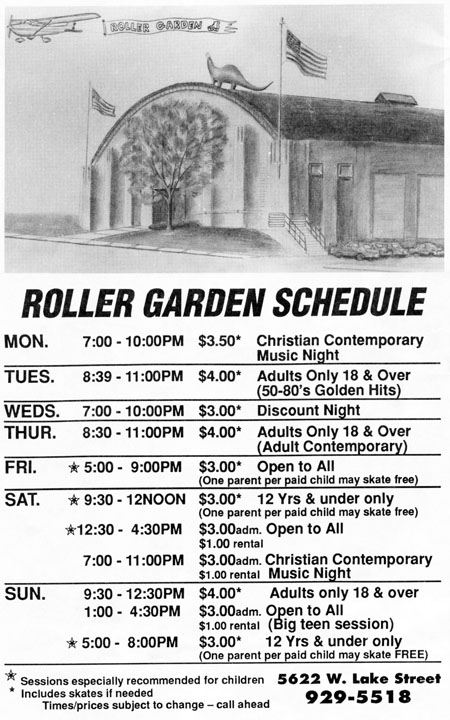
A 1993 article said that wheels on roller skates had changed from wood, metal, and rubber to polyurethane, offering a smoother and quieter ride. Inline skates had also come into fashion, and the rink sponsored roller hockey on Fridays.
A 1998 article described the facility as having:
- 20,000 square feet for skating
- 30,000 total square feet
- 39 foot ceilings
- A 36 inch crystal disco ball
- Track spot lighting
- Fog and effect lights
At the time, every Saturday night was Christian Rock night.
In 2013 a new maple floor was installed.
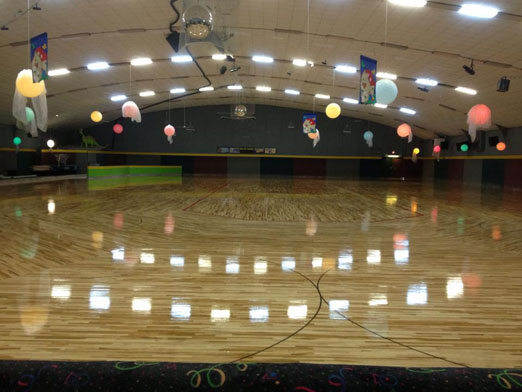
THE SAGA OF THE DINOSAUR
Steve Brown explained the origin of Dino the Dinosaur:
In 1964, my wife, Nancy Hardacker Brown, purchased Dino purchased for about $350 in the grandstand building at the Minnesota State Fair. He was Gold metalflake and was mounted on a platform that sat on four 8″ Sears hard rubber wheels. I made it so one wheel was inside each of Dino’s feet. It had auto- like front wheel steering and the handle was attached to the steering mechanism.
Steve made the cart to wheel his kids around in the rink.

When Johnston purchased the property in 1969, Howard Hardacker gave the dinosaur to a customer and Sahly bought it back for $75. One night after hours someone got hurt riding around on it, so it was decided that it would go up on the roof to stay out of harm’s way. It was painted all kinds of colors over the years, sometimes with polka dots. Well, apparently it isn’t that difficult to get up on the roof, as high school pranksters found out, and after Dino was expelled from the front of the school it was decided to bring him inside, where he sits today, painted a respectable green.
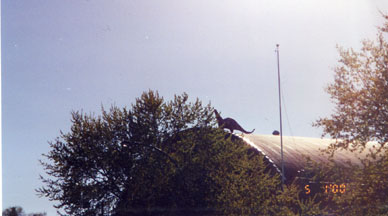
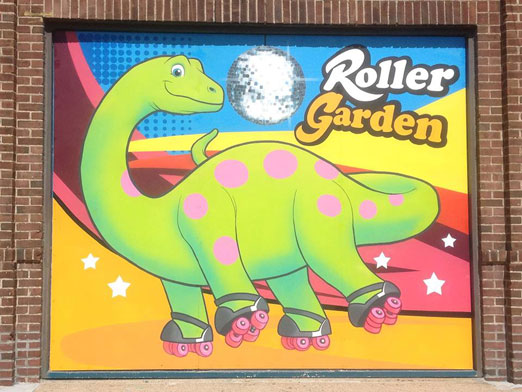
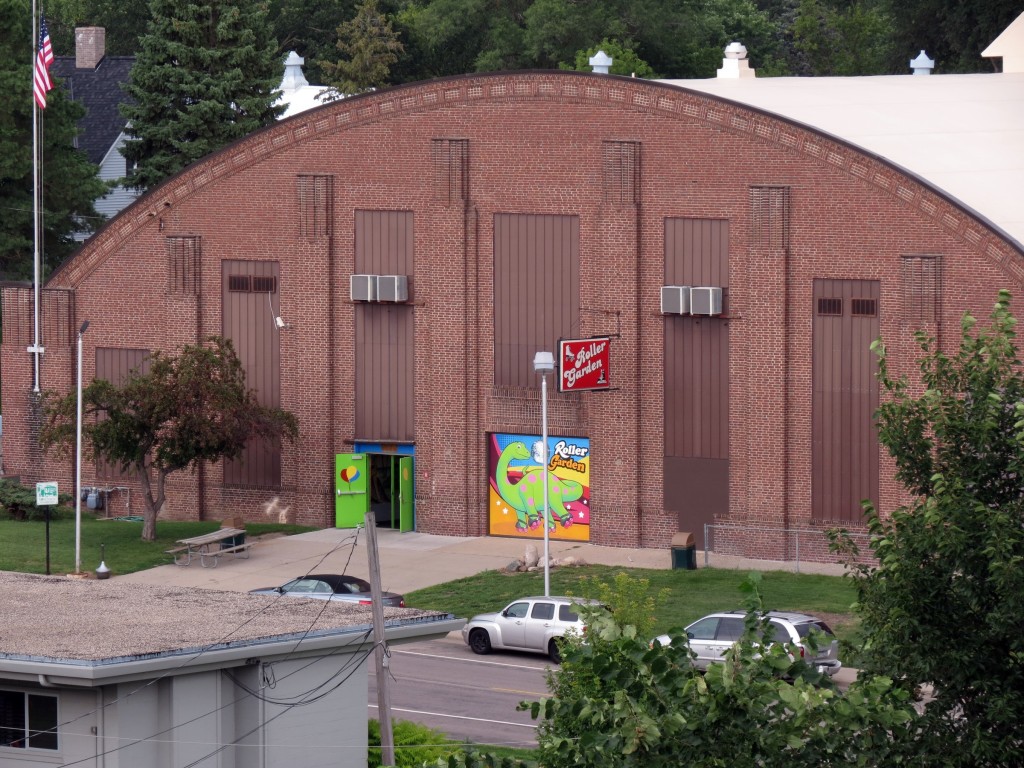
Click here for a segment on the Roller Garden broadcast on the April 7, 1974 “Moore on Sunday” TV show. Commentary by owner Russell Johnston. Courtesy of the Pavek Museum of Broadcasting.
THE SAHLYS RETIRE
On April 19, 2021, the following was posted to the Roller Garden’s Facebook page:
To our skating community, friends and family,
We are saddened to announce that Roller Garden will be closing the doors for the final time on Saturday, May 8th. It has been 52 years since beginning our families journey into the world of roller skating. We have proudly provided great entertainment for kids, adults, families, schools, churches, daycare groups, scouts, colleges, choirs, companies, and more birthday celebrations than we can count (even a wedding). It has been a privilege to see all the smiles and happiness of our skaters, watching them grow up, bring their children, grandchildren and even great grandchildren.
This was an incredibly difficult family decision which was not taken lightly. There were many contributing factors over the years, including the owners desire to retire, that led us in this direction, and then covid hit, which literally pushed us over the edge. The challenges of this past year made us realize how short life is, and the amount of time we’ve missed with our own families in order to run this business. We would’ve loved to see this historical facility remain a roller rink but we’re happy to at least know it’s not being torn down and will be run by another family owned business.
We would like to thank all of our skaters, past/present employees, friends and family for your loyalty over the years. Our customers and staff have been the heart and soul of Roller Garden, the reason we’ve continued for so long. We appreciate all of you for your positive support. It will be extremely difficult to say goodbye. We hope that we have been able to provide memories that will last a lifetime, as you have done for us.
We sincerely hope you will all continue your passion for roller skating. We encourage you to keep rolling at either Skateville in Burnsville or Cheapskate in Coon Rapids. They are great facilities run by caring people who would be thrilled to have you join them.
A “Week of Goodbyes” is being planned for May 2nd – May 8th. More information coming soon.
Sincerely,
The Roller Garden Family
References: (Some dates and newspapers not available)
“Park Council Refuses to Act on License War,” October 1929
“Minneapolis Group to Erect $40,000 Horse Show Arena”
“Horse Fanciers of City to Build $40,000 Arena,” October 8, 1929
“Riding Ring at Park to Cost $55,000”
“Large Riding Arena to Open in May; Big Riding Arena Near Completion,” Percy E Turner
Profile of Herbert B. Allen, Famous Saddle Horses and Distinguished Horsemen
“Polo Takes on New Life at Pastime Rink,” Minneapolis Journal.
“Daniels’ Team Gains Polo Tourney Fours,” Percy Turner
“Allens, Egans Feature Play in Polo Meet”
“Maroon Four to Play Army,” Percy Turner
“Pastime Polo Four Wallops 4 Horsemen”
“Army, Pastime Poloists Win,” Percy E. Turner
“Pastime’s Indoor Tournament,” Rail Byrd, Golfer and Sportsman Magazine, February 1934
“Pastime Wins Polo Thriller,” Percy E. Turner
“Consolation Play Starts in Polo Meet,” Waldo S. Ahlstrom
“Pastime Tips Donaldsons,” Percy E. Turner
“Rousing Games Open Indoor Tourney,” Percy Turner
“Maroons to Meet Blacks For Polo Top,” Waldo S. Ahlstrom
“Junior Horse Show Season Will Open,” Minneapolis Journal, January 5, 1931
“Elite Horses Thrill Crowd at Woodhill,” Percy E. Turner
“Lincoln Horse Wins at Show,” Percy E. Turner
“Young Riders Show Skill in Pastime Ring”
“New Horse Proves Sensation at Show,” Percy Turner
“Mare Takes Bow in Oils; Horse Picture Amazes Critic,” Percy Turner, Minneapolis Tribune, December 1, 1932
“Owner Rescues 30 Horses From Burning Barn,” 1941
“Victory Horse Show Planned on Two Days,” September 4, 1942
“Curfew Law, School Space Engage Council’s Attention,” SLP Dispatch, January 28, 1944
“Parents Invited to Council Meet On New Curfew Law,” SLP Dispatch, February 4, 1944
“Proposed Curfew Given Airing at Council Meet,” SLP Dispatch, February 11, 1944
Ordinance No. 203 Regulating and Licensing Roller Skating Rinks, Passed February 14, 1944
“Petition Asks Bryn Mawr Bus Be Extended to Eliot,” SLP Dispatch, February 25, 1944
“Dispatch Selected As Official Newspaper for Third Year,” SLP Dispatch, March 10, 1944
“Council to Settle Roller Rink Question Next Week,” SLP Dispatch, March 17, 1944
“Roller Rink Denied License By Unanimous Council Vote,” SLP Dispatch, March 24, 1944
“Council Committee, School Board Will meet Monday,” SLP Dispatch, April 7, 1944
“More About Roller Skating,” ad placed by Arthur J. Eaton, SLP Dispatch, April 7, 1944
“Judge Awaits Briefs In Rink Injunction,” SLP Dispatch, April 21, 1944
“Court Enjoins Village From Closing Rink,” SLP Dispatch, April 28, 1944
“Commission Frowns On Academy Area For Industry,” SLP Dispatch, April 28, 1944
“Village Asks for Another Option on Milwaukee Well,” SLP Dispatch, April 28, 1944
“Purchase of Lilac Way Academy For Industrial Purposes is Approve,” SLP Dispatch, May 5, 1944
“Public Hearing Called on Lilac Way Problem,” SLP Dispatch, May 12, 1944
“100 Jam Chambers to see Village Wheels go Round,” SLP Dispatch, May 19, 1944
“Ride Academy Defendant in $20,000 Suit,” SLP Dispatch, June 30, 1944
“Tar Mat Ordered Along Proposed New Bus Line,” SLP Dispatch, August 11, 1944
“Board Will be Asked to Close Grades Election Day,” SLP Dispatch, September 29, 1944
“Budget, Storm Sewer Discussed by Council,” SLP Dispatch, October 6, 1944
“Priorities are Obstacle For Sewer Project,” SLP Dispatch, November 17, 1944
“Roller Garden is Example of Good Human Relations,” Sy Friedman, Letter to the Editor, SLP Sun, April 2, 1970
“Roller Garden History Lesson,” Larry Batson, Minneapolis Star, November 13, 1974
“Racket Big and Illegal,” Barbara Flanagan, Minneapolis Star, 1976
“Another go-around over roller rink noise,” Minneapolis Star and Tribune, July 14, 1983
“Roller Garden files Lawsuit,” St. Louis Park Sailor, September 26, 1990
“Roller Garden marks 50th anniversary in SLP,” SLP Sun-Sailor, November 3, 1993
“Skating Rink is rolling with the changes,” SLP Sun Sailor, November 4, 1998
Obituary of Arthur J. Eaton, Minneapolis Star Tribune, November 3, 2016
“Arthur Eaton, horse breeder and Apple Valley developer, dies at 87,” John Ewoldt, Minneapolis Star Tribune, November 17, 2016
